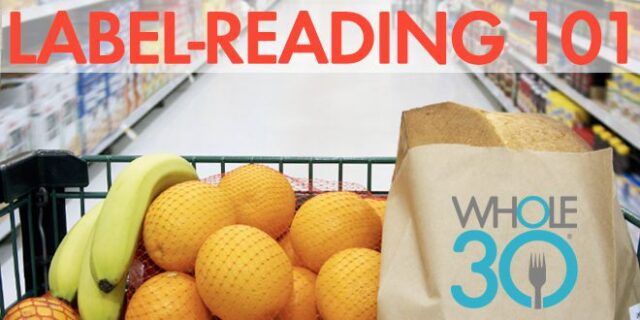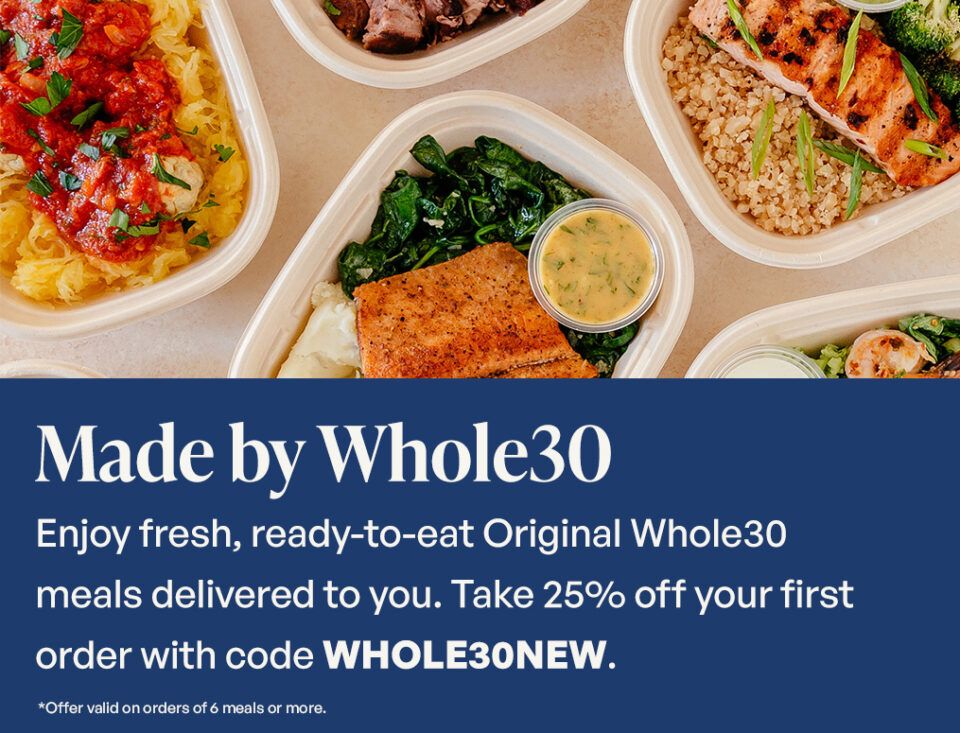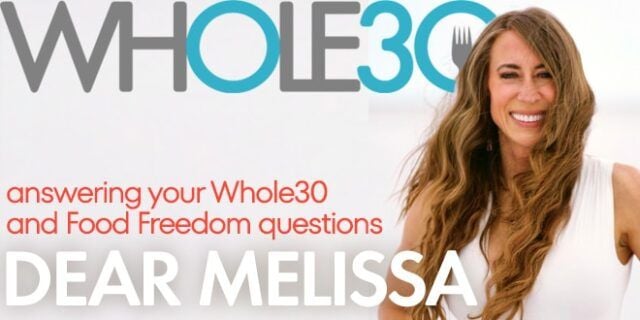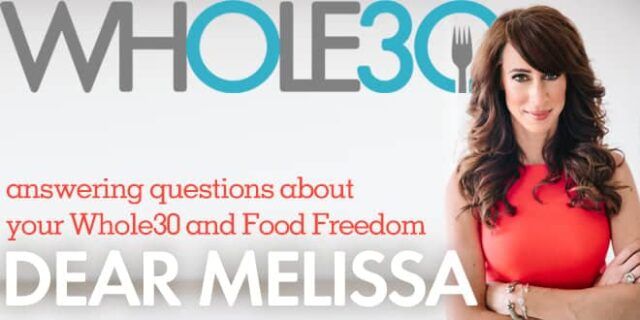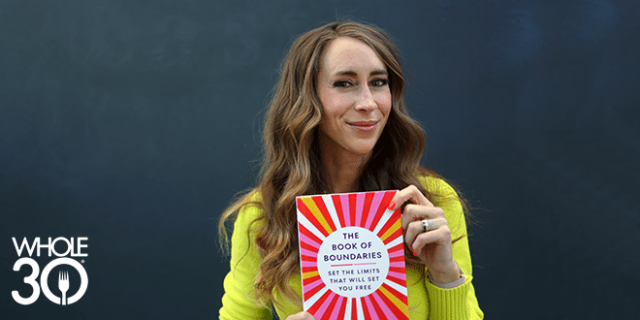You’ve committed to the Whole30. You’re ready to change your life. You’re following all the steps in our getting started guide, and you’re ready to hit the grocery store to stock up on healthy Whole30 foods. You start with your meat, seafood, and eggs—easy! Ground beef, chicken thighs, salmon, and eggs—check. Time for produce—so easy! Every color of the rainbow goes in your cart in the form of fresh vegetables and fruit, and you’re thinking, “This Whole30 thing is a piece of cake kale.”
Then you hit the aisles, and your Whole30 momentum comes to a screeching halt smack in front of the canned tomatoes and olives. Citric acid? Calcium chloride? Ferrous gluconate? What the heck are those? Can I have those? I should Google these. WHAT EVIL CORPORATE FOOD CONGLOMERATE IS BLOCKING CELL PHONE SERVICE TO AISLE 4.
Don’t let this happen to you, because the Whole30 is stressful enough without factoring in a panic attack in the middle of Market Basket. Today, as the newest addition to our Whole30 101 series, we’re going to help you develop your label-reading skills so you can breeze through the grocery store with ease.
Step 1: Read the Whole30 Rules
Yes, we know. You’ve read the rules of the program. You know you’re supposed to avoid sugar and grains and dairy and beans. You’ve got this, right? Oh but what about quinoa? Edamame? Stevia? These things are all spelled out right in the rules (spoiler alert: they’re all a “no”), but unless you’ve really studied all the fine print or are super familiar with a standard Paleo protocol, some of these foods or ingredients can easily trip you up.
So, read the rules. Then read them again. And again, please. The more familiar you are with what’s off-limits, the easier it will be for you to read a label—any “label,” whether it’s a grocery store product, a Pinterest recipe, or a restaurant menu—with ease.
Step 2: Read the Allergy Warning
Most people pick up a product and start reading the ingredients one-by-one. But sometimes the ingredients don’t tell the whole story—and if the list is long, it’s easy to miss something. (A long ingredient list isn’t by default a bad thing! Some Whole30-compatible vegetable soups at our local health food store have a long list because use a large variety of veggies).
So take a shortcut, and head straight to the allergy statement. That’s the bolded notation in the ingredient list itself, or the all-caps “contains” statement found on all USDA-approved foods, clearly stating if the food contains one of the following 8 allergens: milk, eggs, fish, Crustacean shellfish, tree nuts, peanuts, wheat, and soybeans.
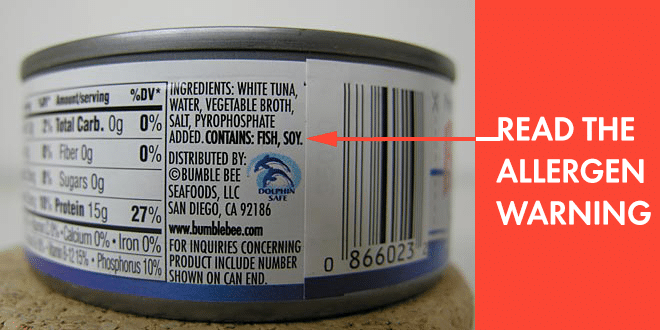
Of these, any allergy statement that says the product contains milk, peanuts, wheat, or soy(beans) means the product is immediately ruled out for your Whole30. This is key, because sometimes products get sneaky about their labels. Canned tuna is a common one—their “vegetable broth” usually contains soybeans, which isn’t apparent in the ingredient list, but is clear in the allergy statement.
Note: companies may also include a “precautionary label” using terms such as “processed in a facility that also processes…” or “manufactured on equipment that uses…”. While not required by federal regulation, this type of label is used by food manufacturers when there actually is a possibility (however small) that the food may contain an allergen which is not an ingredient but may be present as a result of the manufacturing process. The items on this label will not rule the product out for your Whole30, but if you have a serious known allergy to one of the ingredients listed, take note.
Step 3: Read the Ingredient List
If there is nothing overtly specified in the allergy warning, it’s time to run through the ingredients carefully. Added sugar, off-limits additives like carrageenan or added sulfites, corn starch, or rice bran won’t be listed on an allergy warning, but will rule the product out for your Whole30.
Thing is, things can get sneaky here, too. Added sugar comes in many forms, some of which sound downright healthy. (Agave nectar practically sounds like nourishment from the gods, instead of just another source of fructose-rich added sugar.) As for additives… you practically need a Ph.D. to translate the names of some of these ingredients and evaluate whether certain additives are healthy or harmful to your health.
Lucky for you, we’ve created some Whole30 cheat-sheets to help you navigate your labels with ease.
Our Guide to Sneaky Sugars helps you identify all the ways companies may sneak sugar into their products under names you might not immediately spot as sugar. If you see any of these ingredients listed on your label, that means the product is immediately out for your Whole30.
The Common Additives Cheat Sheet is designed to help you identify additives that are expressly off-limits for the Whole30 program, and learn more about the purpose of other acceptable additives in your food. Note, however, that “acceptable” doesn’t mean we enthusiastically endorse the inclusion of these additives in your food.
To make the Whole30 both maximally effective and easy to follow, we’ve narrowed down our list of “off-limits” additives to two especially nasty substances: carrageenan and added sulfites. (You can read more about why we excluded these two in particular in our book, The Whole30.) There are other additives (like guar gum or citric acid) that are generally safe for most, but may affect very sensitive individuals. Still other additives sound scary (like ascorbic acid), but are actually totally benign… that’s just the science-y name for vitamin C.
Bottom line: we always encourage you to search for additive-free foods, and educate yourself about the purpose of additives in your foods. Our guide explains some of the most commonly seen additives in Whole30 foods, so print it and take it to the store with you to help you select Whole30-compatible canned goods, broths, or almond milk with ease.
Note: Many truly nasty additives (like artificial colors) aren’t on our list, because following the Whole30 rules means you have a near-zero chance of ever encountering them. But if you ever find yourself stuck in the store wondering what that complicated-sounding ingredient actually does, Google! Wikipedia is a good source of basic information for nearly all food additives world-wide.
Third: Can’t Find It? Make it Yourself!
Finally, if you’re having a really hard time finding a compatible salad dressing, canned tuna, or deli meat in your local grocery store, ask yourself, “Can I make my own alternative?” Chances are with a little planning and preparation, you can work around any pre-packaged food with a Whole30-friendly recipe.
The Whole30 features more than 100 recipes for Whole30 staples like:
- Homemade broth
- Protein salad
- Sausage
- Salad Dressings
- Ketchup
- Mayonnaise
- Barbeque Sauce
And more! Our @Whole30 Recipes Instagram feed is another amazing source of inspiration, featuring a new guest blogger with a variety of Whole30 recipes, kitchen tips, and cooking skills each week. Or, Google “Whole30 + ingredient,” and chances are the internet will provide you with an alternative or twelve. (Just remember, read your recipes like you read your labels! Unless it’s posted on our official Whole30 social media feed or website, we can’t guarantee it’s actually Whole30 compatible.)
Congratulations! You’re a Label-Reading Expert!
In summary, while it may seem tedious to read every single label when you first begin the Whole30, with practice, this will become second nature. Even after your Whole30 is over, you’ll find yourself scanning labels effortlessly and automatically, passing on things that you (now) know make you less healthy, keeping the habits you learned during your program alive long after Day 31.

